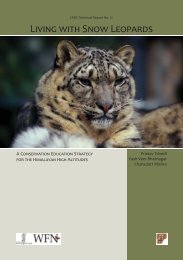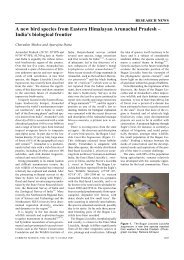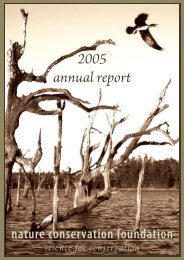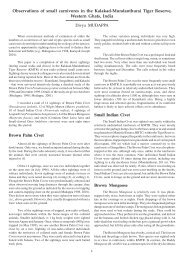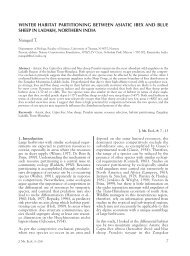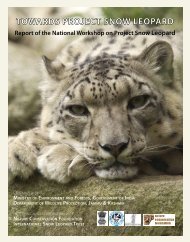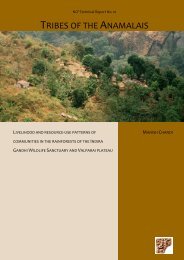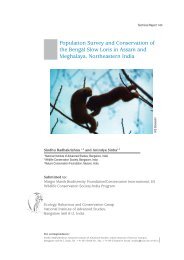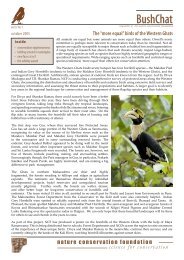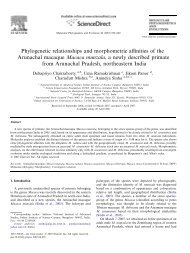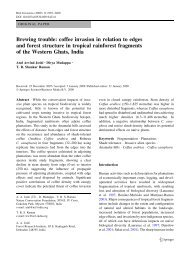2006-7 annual report - Nature Conservation Foundation
2006-7 annual report - Nature Conservation Foundation
2006-7 annual report - Nature Conservation Foundation
Create successful ePaper yourself
Turn your PDF publications into a flip-book with our unique Google optimized e-Paper software.
start of the breeding season (February-March). It appears<br />
that Wreathed hornbills are not resident or are<br />
present in very low numbers during the winter months<br />
with only 13 sightings between October and January<br />
(non-breeding season), while in the breeding season<br />
(February to May) there were more sightings (25). Encounter<br />
rates were low in the months of October and<br />
November, with no Wreathed hornbills seen in December-January.<br />
Wreathed hornbills re-appeared in the<br />
area again at the commencement of the breeding season<br />
in February. Wreathed Hornbills appear to be seminomadic<br />
and move into higher areas during periods of<br />
fruit scarcity. Great Hornbill abundance does not vary<br />
seasonally and they are resident throughout the year in<br />
lowland forests.<br />
Establishing baselines: long-term monitoring of threatened wildlife with local communities in<br />
two important protected areas in Arunachal Pradesh, north-east India<br />
The monitoring of wildlife populations is an important<br />
component of a wildlife conservation program. In the<br />
Namdapha National Park, the single largest threat is<br />
hunting by humans: therefore our efforts focused on<br />
establishing the impacts of hunting on wildlife populations.<br />
We targeted species known to be most affected by<br />
hunting —terrestrial mammals and large birds (pheasants<br />
and hornbills)—for monitoring. We aim to use this<br />
research to assess our community-based conservation<br />
initiatives: we expect that a reduction in hunting within<br />
Namdapha National Park will result in recovery of animal<br />
populations. The current estimates will serve as a<br />
baseline for future comparisons. We also monitor similar<br />
faunal groups in Pakke Wildlife Sanctuary in order<br />
to make spatial comparisons between two of the most<br />
important PAs in Arunachal Pradesh.<br />
We set up a wildlife monitoring system with<br />
trained local villagers (tribal ex-hunters) at Pakke WLS<br />
and Namdapha NP, two important Protected Areas in<br />
Arunachal Pradesh that are both tiger reserves. Camera<br />
trapping to record species richness and relative abundance<br />
for species threatened by hunting was established.<br />
For the first time systematic monitoring protocols using<br />
camera traps have been used in Protected Areas in<br />
North-east India. Seven field staff (4 in Namdapha, 3 in<br />
Pakke) from local communities (tribal ex-hunters) have<br />
been trained and assist in the field monitoring effort. In<br />
addition, 2 graduate students, 1 volunteer, and 8 other<br />
tribal youth were involved in the 3 month field monitoring<br />
effort in Namdapha this year.<br />
Wildlife monitoring in Pakke WLS & TR<br />
Trail monitoring in Pakke WLS<br />
A total of 11 trails were marked and walked an average<br />
of 8 times with 182 km walked between 2004 and<br />
<strong>2006</strong> in which 18 species were observed, including four<br />
ungulate species, three primate species, four squirrel<br />
species, three pheasant and three hornbill species. The<br />
encounter rates are summarized in Table 1.<br />
Camera trap surveys in Pakke WLS<br />
The number of mammal species in key faunal groups is<br />
<strong>report</strong>ed to be 45, while through our surveys, direct and<br />
indirect evidence for 34 were recorded. In Pakke, pilot<br />
camera trap surveys were conducted sporadically between<br />
Dec 2005 and May <strong>2006</strong> and September - October<br />
<strong>2006</strong> with a total trapping effort of 231 trap nights<br />
that resulted in photo captures for 14 larger mammal<br />
species.<br />
Wildlife monitoring in Namdapha NP & TR<br />
The number of large mammal species in key faunal<br />
groups is <strong>report</strong>ed to be 56 in Namdapha. We recorded<br />
21 of these on camera traps, while 27 others were recorded<br />
by other methods or reliable evidence. No direct<br />
or indirect recent evidence could be found for 8 species.<br />
Although no evidence for tiger and elephant presence<br />
was found in winter <strong>2006</strong>-07, we include them as still<br />
present based on indirect evidence seen in 2004-06.<br />
In the first year (winter 2005-06) with 10 camera<br />
trap units, we had a limited sampling effort of 364 trap<br />
nights at Namdapha. In winter <strong>2006</strong>-07, a large-scale<br />
camera trapping survey was carried out in the 1,985<br />
km 2 Namdapha National Park. Our intensive study area<br />
of 1200 km 2 encompassed the moist evergreen forests<br />
below 2000 m of the park. A uniform grid (3 x 3 km)<br />
was imposed on a map of the area. Of the 130 grids covering<br />
the study area, a random selection of 80 grids was<br />
made. With only 16 km of motorable road, all field work<br />
was carried out on foot. Given logistic difficulties in the<br />
hilly terrain, limitations of time, manpower and equipment,<br />
sampling was carried out between October <strong>2006</strong><br />
<strong>annual</strong><br />
<strong>report</strong><br />
15



